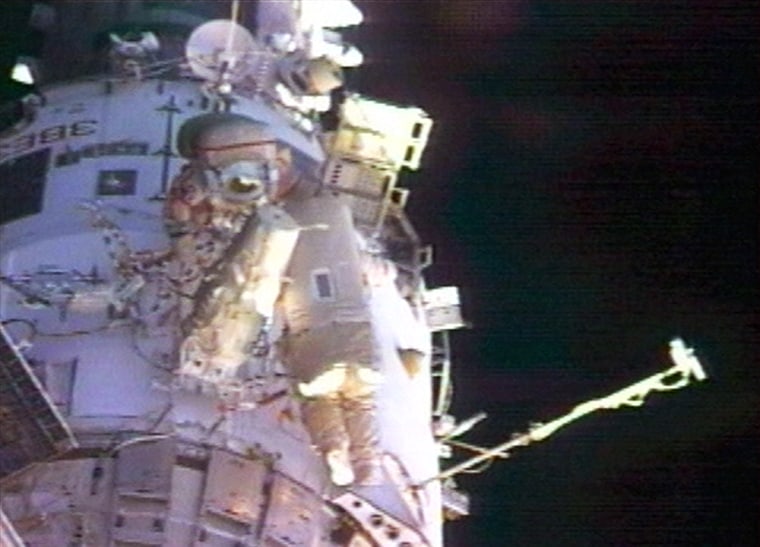The international space station's two astronauts left their orbiting home in the hands of ground controllers Wednesday and floated outside to install an experimental robotic arm and inspect vents that might be causing air-supply equipment breakdowns.
Leroy Chiao and Salizhan Sharipov found goo on the vents and hooked up the arm, solving a minor problem with a loose electrical connection on the elaborate robot system shortly before the spacewalk drew to a close.
“Everything’s perfect,” Mission Control radioed. “Well, thank God, thank God,” came the reply. Before going back inside, they were advised: “Take a breather.”
The spacewalk — unable to be completely televised because of a cold station antenna — was the first in Chiao and Sharipov’s mission, now at the 3½-month point.
'Hello, space'
“Hello, space, my old friend,” Chiao, a veteran spacewalker, said as he exited.
A little earlier, flight controllers teased Sharipov for singing as he got ready to make his first-ever spacewalk. “You could hear that, huh?” he asked with a laugh. The singing and humming continued outside.
Because of the grounding of NASA’s shuttle fleet, the international space station has been limited to two residents, one fewer than usual. As a result, no one was left inside during the spacewalk to monitor station systems, and flight controllers kept tabs on things, an increasingly common practice in the wake of the Columbia disaster two years ago.
Controllers did not get to see the start of the spacewalk 225 miles (360 kilometers) up because of an unusually cold dish antenna, which was parked in a fixed position at the station. They settled for audio only.
But the antenna warmed up sooner in the sunlight than expected, and live TV images of the station filled Mission Control’s screens less than an hour into the spacewalk. The crisp images lasted only minutes, however, and reappeared sporadically.
Quick work
Chiao, the American commander, and Sharipov, a Russian, promptly set up the mini-robotic arm that arrived on Christmas Day along with much-needed groceries. Food and water were running so low that the spacemen went on a lengthy diet that ended only when the supply ship showed up.
They had a month of hearty eating to beef up for the 5½-hour Russian-managed spacewalk, which involved hauling the robotic arm and its platform over 100 feet (30 meters).
Germany’s $10 million arm — a 20-inch (50-centimeter) device featuring two joints, two cameras and a fingerlike pin at the end — is a smaller, simpler version of what engineers hope will lead to satellite-repair robonauts in perhaps a few years. An advanced version also could be placed on a rover and assist astronauts on the moon or Mars by collecting rocks and performing other chores, said Klaus Landzettel, project manager at the German Aerospace Center near Munich.
For now, the objective is simply to see whether the arm can move along a 28-inch (70-centimeter) curved track and survive for a year in the vacuum of space, Landzettel said.
Checking the air system
A late addition to the spacewalk was the inspection of exterior vents for the main oxygen generator and air purifiers.
The Russian oxygen generator has broken down repeatedly, and engineers speculated its vent might be clogged or corroded. The air-cleansing equipment also has a history of malfunctions.
Sharipov found a large patch of dark, oily residue on at least one vent and a white substance — he described it as a honeycomb — on the oxygen generator’s outlet. “They’re going to be very good pictures,” he said as he photographed the goo.
During the spacewalk, flight controllers noticed a repeat of the same mysterious forces that tilted the station on previous astronaut outings. Wednesday’s odd, off-center nudges forced the Russian thrusters to take over steering control from the U.S. gyroscopes several times.
Given Tuesday’s late afternoon wake-up, it was expected to be a 20-hour workday for the spacemen, a flight rule violation but a situation that NASA considers unavoidable at times with only two people on board. Flight surgeons vouched for the crew’s strength, even after the mandatory dieting.
One more spacewalk is on tap for Chiao and Sharipov in March, one month before they return to Earth in a Russian capsule.
